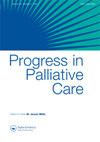Community-based participatory research and Public Health Palliative Care
IF 0.8
Q4 PUBLIC, ENVIRONMENTAL & OCCUPATIONAL HEALTH
引用次数: 1
Abstract
The field of Public Health Palliative Care (PHPC) has grown significantly over the past 20 years, since the inception of health-promoting palliative care. While much has been developed and refined in terms of theoretical basis and practice methods, there is an increasing need to consider the research agenda and methods employed to evaluate outcomes and strengthen the evidence base for public health approaches to palliative and end-of-life care. In particular, promoting the participation of underserved and vulnerable populations and understanding the influence of power structures on their representation in research is imperative. Depending on congruence between epistemological orientation, methodological choices, and options in operationalisation, there is scope to complement traditional research methodologies with new public health approaches that are participatory and directly informed by communities’ lived experience, expressed needs, and aspirations for care. Community-based participatory research (CBPR) represents a prime example, and has been applied to the PHPC model of compassionate communities (referred to as ‘caring communities’ in German-speaking countries). In this context, Wegleitner and Schuchter 2 argue that an ecological health-promotion framework for action must be complemented by social experiential learning processes arising from the collective experiences and wisdom of community members. This and CBPR are consistent with recent literature on reimagining palliative care access through partnerships and community participation. Given the public health benefits of community development and relevance of intersectionality as a transformational paradigm to understand complexities and address power relations within a settings-based social model of health, recommendations have been made to include the prioritisation of active research involvement by patients and the wider public (outside of clinical contexts). Outside of this PHPC context, CBPR has been used to address inequities in access to palliative care and promote social justice for historically excluded groups; however, participatory engagement between clinical services and community groups alone—although helpful —may not be sustainable where it is not supported by societal infrastructure and broader policies that transcend diversity across communities to engage common participation from everyday citizens. Indeed, a wellknown challenge relating to CBPR has been to ground it in a relevant social movement theoretical model for change. Based on the WHO Healthy Cities model, the Compassionate Cities movement is an example of a civic programme that has been implemented across cities worldwide. The Compassionate City Charter also forms a key component of Abel and colleagues’ new essentials public health model of palliative care, encapsulating: (1) Civic programmes; (2) Compassionate Communities; (3) Generalist Palliative Care; and (4) Specialist Palliative Care. Thus CBPR can usefully be applied within a broader and more explicit PHPC context. That is, through adopting or aligning with new PHPC frameworks that incorporate intersectionality and encompass a broader range of key actors for civic engagement across society. For example, CBPR approaches can directly align with the new essentials public health model of palliative care (Fig. 1). As illustrated throughout the COVID-19 pandemic, this can aid and inform collaborative responses to shared public health concerns. In this way, the strengths of CBPR can be leveraged together with broader public health engagement and shared participation in building more sustainable clinical and societal infrastructures necessary to adapt to diverse community needs during life-limiting illness, end-of-life care, and bereavement.社区参与性研究与公共卫生姑息治疗
自促进健康的姑息治疗开始以来,公共卫生姑息治疗(PHPC)领域在过去20年中显著发展。虽然在理论基础和实践方法方面已经发展和完善了很多,但越来越需要考虑研究议程和用于评估结果的方法,并加强姑息治疗和临终关怀公共卫生方法的证据基础。特别是,促进服务不足和弱势群体的参与,并了解权力结构对他们在研究中的代表性的影响,至关重要。根据认识论取向、方法选择和操作选择之间的一致性,有可能用新的公共卫生方法来补充传统的研究方法,这些方法是参与性的,并直接根据社区的生活经验、表达的需求和对护理的渴望。基于社区的参与性研究(CBPR)是一个典型的例子,并已应用于富有同情心的社区(德语国家称为“关爱社区”)的PHPC模式。在这种背景下,Wegleitner和Schuchter 2认为,生态健康促进行动框架必须辅之以社区成员集体经验和智慧产生的社会体验学习过程。这一点和CBPR与最近关于通过伙伴关系和社区参与重新构想姑息治疗的文献一致。考虑到社区发展对公共卫生的好处,以及交叉性作为一种转换范式的相关性,以理解复杂性并解决基于环境的社会健康模式中的权力关系,已提出建议,包括优先考虑患者和广大公众(临床环境外)积极参与研究。在PHPC的背景之外,CBPR被用来解决在获得姑息治疗方面的不平等问题,并促进历史上被排斥群体的社会正义;然而,如果没有社会基础设施和更广泛的政策的支持,临床服务和社区团体之间的参与性参与虽然有帮助,但可能是不可持续的,这些政策超越了社区的多样性,让普通公民共同参与。事实上,与CBPR相关的一个众所周知的挑战是将其建立在相关的社会运动理论模型中,以促进变革。根据世界卫生组织的健康城市模式,同情城市运动是在世界各地城市实施的公民方案的一个例子。《同情城市宪章》也是Abel及其同事姑息治疗新的基本公共卫生模式的一个关键组成部分,包括:(1)公民方案;(2) 同情社区;(3) 全科姑息治疗;和(4)专科姑息治疗。因此,CBPR可以有效地应用于更广泛、更明确的PHPC环境中。也就是说,通过采用或与新的PHPC框架保持一致,这些框架包含了交叉性,并涵盖了更广泛的关键参与者,以促进整个社会的公民参与。例如,CBPR方法可以直接与姑息治疗的新的基本公共卫生模式相一致(图1)。正如整个新冠肺炎大流行所表明的那样,这可以帮助并为共同的公共卫生问题的合作应对提供信息。通过这种方式,CBPR的优势可以与更广泛的公共卫生参与和共同参与一起发挥作用,建设更可持续的临床和社会基础设施,以适应限制生命的疾病、临终关怀和丧亲之痛期间的不同社区需求。
本文章由计算机程序翻译,如有差异,请以英文原文为准。
求助全文
约1分钟内获得全文
求助全文
来源期刊

PROGRESS IN PALLIATIVE CARE
PUBLIC, ENVIRONMENTAL & OCCUPATIONAL HEALTH-
CiteScore
2.60
自引率
11.80%
发文量
24
期刊介绍:
Progress in Palliative Care is a peer reviewed, multidisciplinary journal with an international perspective. It provides a central point of reference for all members of the palliative care community: medical consultants, nurses, hospital support teams, home care teams, hospice directors and administrators, pain centre staff, social workers, chaplains, counsellors, information staff, paramedical staff and self-help groups. The emphasis of the journal is on the rapid exchange of information amongst those working in palliative care. Progress in Palliative Care embraces all aspects of the management of the problems of end-stage disease.
 求助内容:
求助内容: 应助结果提醒方式:
应助结果提醒方式:


